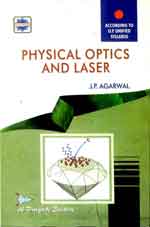|
बी एस-सी - एम एस-सी >> फिजिकल ऑप्टिक्स एण्ड लेजर्स फिजिकल ऑप्टिक्स एण्ड लेजर्सडॉ. जे पी अग्रवाल
|
|
||||||
यूनिफाइड पाठ्यक्रम भौतिक विज्ञान बीएस-सी द्वितीय वर्ष पेपर प्रथम
According to new Unified Syllabus of Physics for B.Sc.-II Paper -I students of all U.P. State Universities
Contents
UNIT – I : INTERFERENCE OF LIGHT
1. Interference Of Light-1 (Division Of Wavefront)... 3-46
1.1. Introduction ... 3
1.2. Two-slit Interference: Young's Experiment ... 4
1.3. Principle of Superposition ... 5
1.4. Interference and conservation of energy ... 7
1.5. Conditions for sustained interference ... 8
1.6. Theory of two slit interference: Fringe width ... 9
1.7. Methods to produce coherent sources ...20
1.8. Fresnel's biprism ...21
1.9. Interference fringes with white light ...25
1.10. Location of zero order fringe in biprisin experiment ...26
1.11. Effect of broadening the source slit on biprims fringes ...26
1.12. Effect of increasing the angle of biprism ...27
1.13. Determination of thickness or u of a transparent plate ...28
1.14. Rayleigh's refractrometer ...34
2. Interference Of Light - II (Division Of Amplitude)
2.1. Introduction ...47
2.2. Division of amplitude by reflection and transmission of light through transparent films …47
2.3. Phase change on reflection: Stoke's law ...48
2.4. Interference exhibited by thin films ...48
2.5. Interference fringes with white light ...51
2.6 Types of Fringes ...51
2.7 Localised and non-localised fringes ...52
2.8. Effect of Thickness of Film on Interference Fringes ...52
2.9. Need of a Broad Source to Observe Interference by Thin film ...53
2.10. Interference of light by wedge shaped film ...58
2.11. Newton's Rings ...62
2.12. Determination of wavelength of sodium light and u of a liquid by Newton’s rings ...65
2.13. Newton's Rings by white light ...67
2.14. Newton's Rings by transmitted light ...67
2.15. Newton's Rings by both surface curved ...67
2.16. Michelson interferometer ...72
2.17. Standardisation of metre ...78
2.18. Twyman and green interferometer ...82
2.19. Multiple beam interferometry ...84
2.20. Fabry perot interferometer ...84
2.21. Fabry Perot Italon ...90
2.22. The Lummer Gehrcke plate ...91
2.23. Tolansky Fringes ...93
2.24. Interference Filters ...105
2.25. Holography ...106
UNIT - II : DIFFRACTION OF LIGHT
3. Diffraction Of Light (Fresnel Class) ... 121-162
3.1. Introduction ...121
3.2. Fresnel's treatment of the wave front ...122
3.3. Fresnel's half period zones: Rectilinear propagation of light ...123
3.4. Zone plate ...128
3.5. Difference between interference and diffraction ...137
3.6. Fresnel and Fraunhofer diffraction ...137
3.7. Diffraction at a circular aperture ...138
3.8. Diffraction at an opaque circular disc ...144
3.9. Cylindrical wave front ...146
3.10. Diffraction at a straight edge ...149
3.11. Diffraction at a narrow wire ...153
4. Diffraction Of Light (Fraunhofer Class)... 163-226
4.1. Introduction ...163
4.2. Composition of n simple harmonic vibrations having consecutive common phase difference ...164
4.3. Fraunhofer diffraction at a single slit ...165
4.4. Intensity distribution in the diffraction pattern of a single slit ...168
4.5. Fraunhofer diffraction at a circular aperture ...172
4.6. Fraunhofer diffraction at two slits ...178
4.7. Diffraction at N slits: (Action of a Diffraction grating) ...185
4.8. Plane transmission diffraction grating ...191
4.9. Plane reflection grating ...191
4.10. Formation of spectrum with a grating ...192
4.11. Width of a principal maxima ...192
4.12. Absent spectra with a diffraction grating ...193
4.13. Overlapping of spectral lines ...194
4.14. Number of spectra with a grating ...195
4.15. Determination of wavelength of light by diffraction grating ...196
4.16. Dispersive power of the grating ...197
4.17. Grating at oblique incidence ...199
4.18. Blazed grating ...210
4.19. Concave reflection grating ...211
4.20. Theory of concave grating ...212
4.21. Concave grating mountings ...213
4.22. Superiority of concave grating over plane grating ...215
5. Resolving Power Of Optical Instruments ... 227-256
5.1. Resolving power ...227
5.2. Rayleigh's criterion of resolution ...227
5.3. Resolving power of telescope ...229
5.4. Relation between magnifying power and the resolving power of telescope ...231
5.5. Difference between magnifying power and resolving power of a telescope ...232
5.6. Resolving power of a microscope ...235
5.7. Resolving power of prism ...239
5.8. Resolving power of a plane diffraction grating ...242
5.9. Difference between resolving power and dispersive power of a grating ...244
5.10. Comparison of prism and grating spectra ...244
5.11. Resolving power of Fabry Perot Interferometer ...249
UNIT - III: POLARISATION OF LIGHT
6. Polarisation Of Light And Double Refraction ...257-306
6.1. Introduction ...257
6.2. Plane polarised light ...261
6.3. Pictorial representation of light vibrations ...262
6.4. Methods to produce plane polarized light ...262
6.5. Plane polarized light by reflection ...263
6.6. Brewster's Law ...265
6.7. Plane polarized light by refraction (pile of plates) ...266
6.8. Law of Malus ...268
6.9. Double refraction or Birefringence ...274
6.10. Geometry of calcite crystal ...275
6.11. Optic axis ...276
6.12. Principal section and principal plane ...276
6.13. Production of polarized light by double refraction ...277
6.14. Nicol prims ...280
6.15. Parallel and crossed Nicols ...282
6.16. Huygen's theory of double refraction in uniaxial crystals ...283
6.17. Huygen's construction for double refraction in uniaxial crystals ...285 6.18. Refractive indices for O and Erays ...291
6.19. Double image polarizing prisms ...293
6.20. Polarization by selective absorption by crystals : Dichroism ...294
6.21. Polaroids ...294
7. Production And Analysis Of Polarized Light...307-336
7.1. Introduction ...307
7.2. Superposition of two plane polarized waves having perpendicular vibrations: The elliptically and circularly polarized light ...307
7.3. Quarter wave plate ...310
7.4. Half wave plate ...311
7.5. Production of plane elliptically and circularly polarised light ...312
7.6. Detection of plane, circularly and elliptically polarised light ...314
7.7. Systematic analysis of polarised light ...316
7.8. Distinction between quarter wave and half wave plates ...317
7.9. Babinet compensator ...318
7.10. Interference of polarised light ...324
8. Optical Activity (The Rotatory Polarization) ...337-360
8.1. Introduction ...337
8.2. Laws of rotation of plane of polarisation ...338
8.3. Fresnel's explanation of optical rotation ...339
8.4. Experimental verification of Fresnel's Theory ...342
8.5. Origin of optical activity in inorganic crystals ...342
8.6. Physical Explanation (Origin) of optical activity in liquids and solutions ...343
8.7. Specific rotation and molecular rotation ...344
8.8. Polarimeters ...345
8.9. Laurent's half shade polarimeter ...346
8.10. Biquartz polarimeter ...348
9. Matrix Representation Of Polarized Waves : Jone's Vector And Jone's Matrix ... 361-376
9.1. Introduction ...361
9.2. Jone's vector and matrix for plane polarized waves ...361
9.3. Matrix for linear polarizer ....363
9.4. Matrix for circular polarizer ...365
9.5. Matrix for retarders ...366
9.6. Application of matrix to babinet compensator ...368
UNIT - IV : LASER SYSTEMS
10. Laser System And Applications ... 379-408
10.1. Introduction ...379
10.2 Spontaneous and Stimulated emissions ...379
10.3. Einstein A and B Coefficients ...381
10.4. Temporal and spatial coherence ...383
10.5. Purity of spectral lines ...385
10.6. Population Inversion ...387
10.7. Pumping ...389
10.8. Optical Pumping ...390
10.9. Principle of Laser-conditions of laser action ...391
10.10. Classification of Lasers ...391
10.11. The Ruby Laser-A pulsed Laser ...392
10.12. He-Ne Gas Laser- A continuous wave laser ...394
10.13. Liquid (or Dye) Lasers-the tuneable lasers ...395
10.14. Semiconductor Lasers ...399
10.15. Characteristics of a Laser beam ...400
10.16. Applications of Lasers ...403
|
|||||

 i
i 










